Author: Marshall Schott
Of the many beer styles humans have come up with over the centuries, none seem to require a more narrow set of methods and ingredients as the relatively novel New England IPA. Purported by advocates as distinguishing itself from typical IPA in its juiciness and soft mouthfeel, an apparent function of its characteristic haze, ensuring the presence of said features is paramount. From the first time I heard of this style, yeast has been a topic of much consideration, with brewers tending to prefer specific strains not only for the ester profile they impart, but their ability to convert certain hop compounds into new compounds via the biotransformation process.
The first yeast that seemed to get the most attention when hazy IPA became a thing was the much lauded “Conan” used by The Alchemist to ferment it’s popular Heady Topper. It wasn’t long after that I began to see references to other yeasts of English origin being used to make NEIPA with success including Safale S-04, WLP007 Dry English Ale, and perhaps the most common of late, Wyeast 1318 London Ale III. Though different in their own right, anyone looking to make an up-to-snuff NEIPA can use either of these strains to achieve good results.
In a recent xBmt on the same topic, tasters were unable to reliably tell apart a NEIPA fermented with Conan from one fermented with WY1318, both strains said to have biotransformation abilities. In my quest for greater clarity on this murky style, and having noticed quite a few NEIPA recipes popping up with the popular Chico strain variants on the ingredients list, I decided to see for myself just how big of an impact yeast has on NEIPA!
| PURPOSE |
To evaluate the differences between a New England IPA fermented with Wyeast 1318 London Ale III yeast and the same beer fermented with Wyeast 1056 American Ale yeast.
| METHODS |
The recipe for this xBmt was the same as the one for the biotransformation xBmt, which was based on the NEIPA I made for the flaked oats xBmt with some minor changes.
Pond Hopper NEIPA
Recipe Details
| Batch Size | Boil Time | IBU | SRM | Est. OG | Est. FG | ABV |
|---|---|---|---|---|---|---|
| 5.5 gal | 60 min | 42.8 IBUs | 3.7 SRM | 1.056 | 1.013 | 5.7 % |
| Actuals | 1.056 | 1.015 | 5.4 % | |||
Fermentables
| Name | Amount | % |
|---|---|---|
| Pale Malt (2 Row), Rahr | 11 lbs | 88 |
| Oats, Flaked | 1.5 lbs | 12 |
Hops
| Name | Amount | Time | Use | Form | Alpha % |
|---|---|---|---|---|---|
| Columbus/Tomahawk/Zeus (CTZ) | 8 g | 30 min | Boil | Pellet | 13.1 |
| Centennial | 30 g | 15 min | Boil | Pellet | 8.8 |
| Centennial | 30 g | 5 min | Boil | Pellet | 9.9 |
| Citra | 30 g | 5 min | Boil | Pellet | 14 |
| Mosaic | 30 g | 5 min | Boil | Pellet | 10.5 |
| Citra | 60 g | 6 days | Dry Hop | Pellet | 14 |
| Centennial | 30 g | 6 days | Dry Hop | Pellet | 8.8 |
| Mosaic | 30 g | 6 days | Dry Hop | Pellet | 10.5 |
| Citra | 33 g | 4 days | Dry Hop | Pellet | 14 |
| Centennial | 22 g | 4 days | Dry Hop | Pellet | 8.8 |
| Mosaic | 20 g | 4 days | Dry Hop | Pellet | 10.5 |
Yeast
| Name | Lab | Attenuation | Temperature |
|---|---|---|---|
| London Ale III OR American Ale (1318/1056) | Wyeast Labs | 73% | 64°F - 74°F |
Notes
| Water Profile: Ca 135 | Mg 1 | Na 10 | SO4 71 | Cl 186 | pH 5.4 |
Download
| Download this recipe's BeerXML file |
Starters with both yeasts were prepared a couple days ahead of brewing.
I prepared the water, which was adjusted to a common NEIPA profile high in chloride, and milled the grain the night prior to brewing.
I awoke early the next morning and lit the burner under my kettle full of liquor.
Once heated to just above my target strike temperature, I transferred the water to my mash tun, let it sit for 5 minutes to preheat, then incorporated the grist to hit my desired mash temperature.
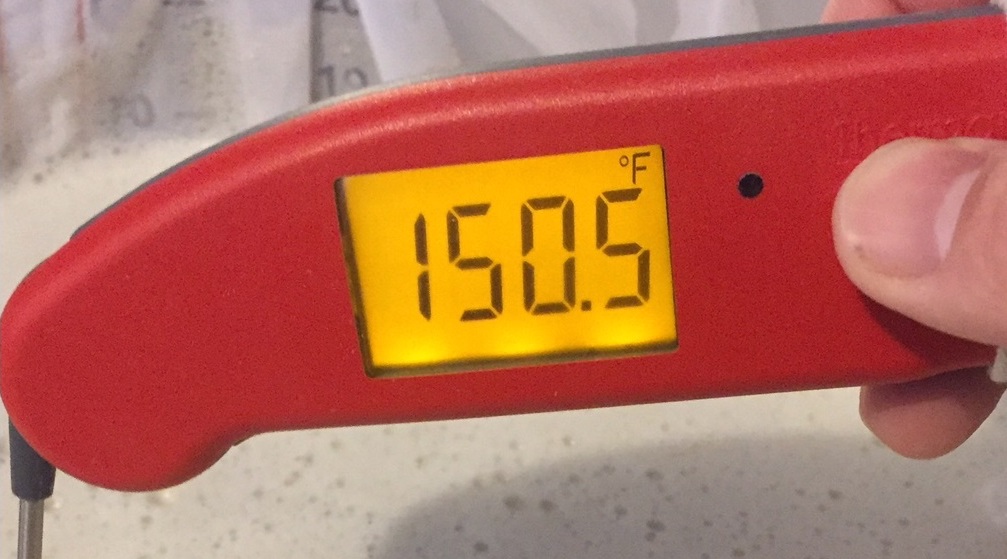
I used the no sparge method for this beer and let the mash rest for 60 minutes.
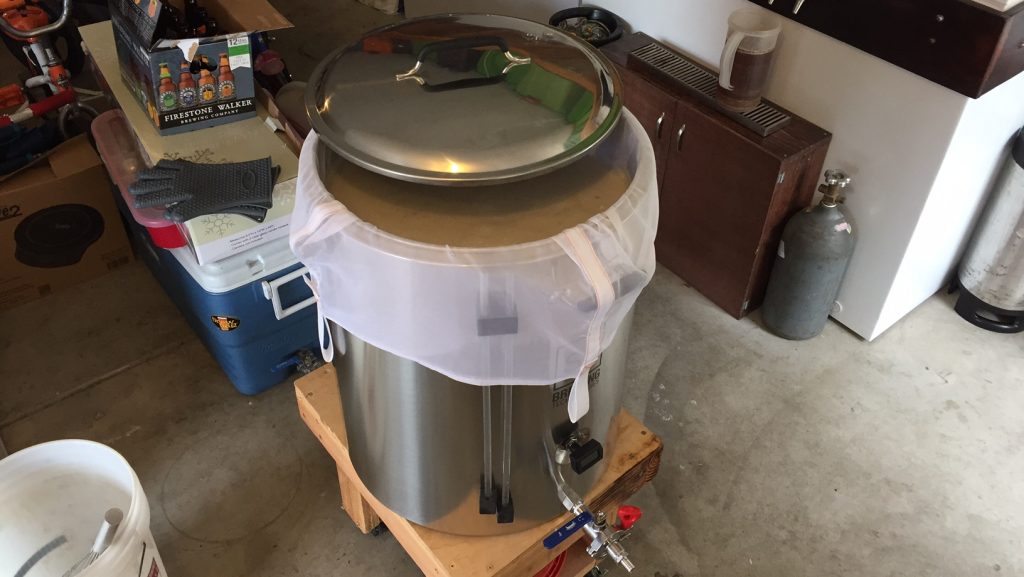
At the completion of the mash step, I collected the sweet wort and transferred it to my kettle.
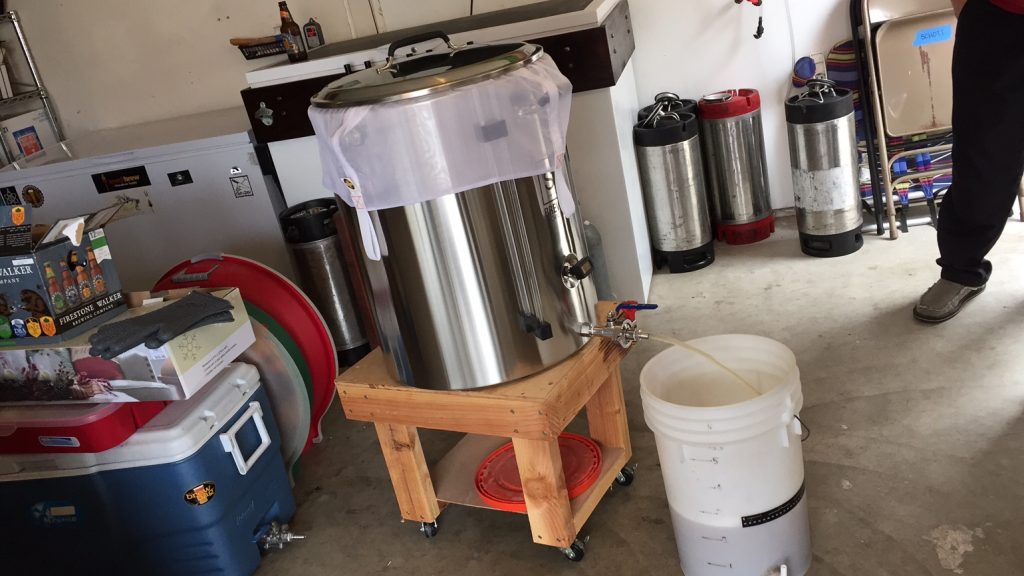
The wort was boiled for 60 minutes with hops being added at the times listed in the recipe.
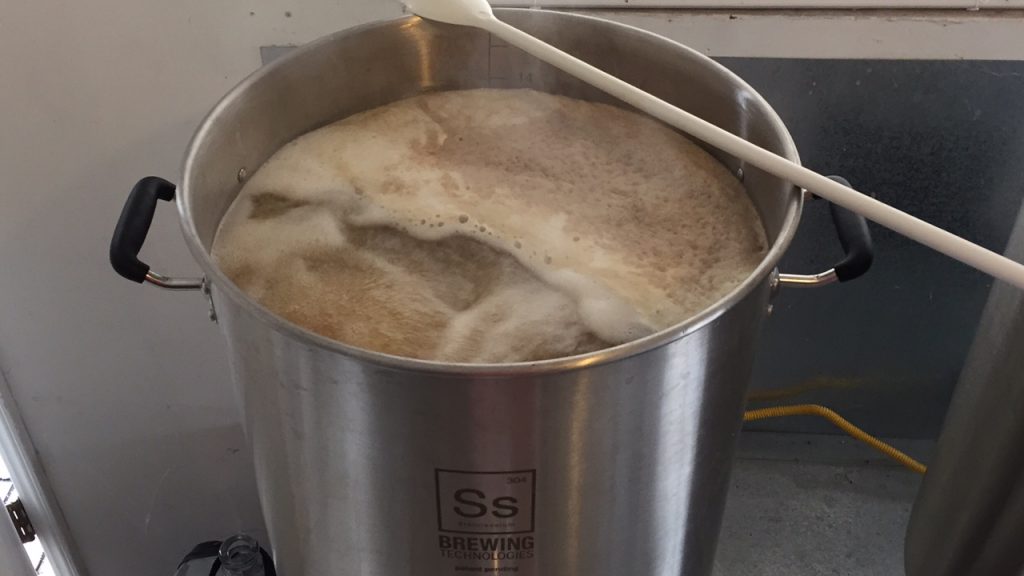
I hastily chilled the wort once the boil was complete.

A refractomer reading at this point showed the wort to be right at my target OG.
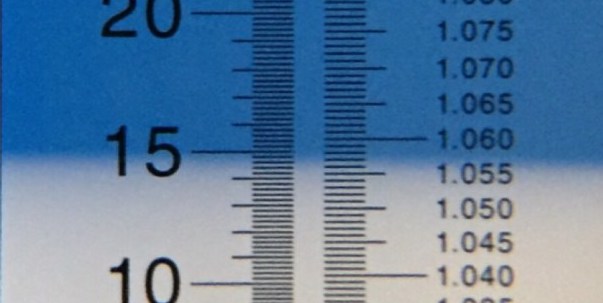
I transferred equal amounts of wort to separate fermentors, gently stirring occasionally to ensure both batches received a similar amount of kettle trub, then pitched the yeast.
Two days post-pitch, both beers were rocking hard enough that I had to replace the airlocks with blowoff rigs.
It was at this point I added the biotransformation dry hop charges to each batch. The beers were left to ferment for another 2 days before I raised the temperature from 66˚F/19˚C to 72˚F/22˚C to encourage complete attenuation. After 2 days at the warmer temperature, with signs of fermentation all but absent, I took hydrometer measurements that revealed a rather drastic difference in overall attenuation.
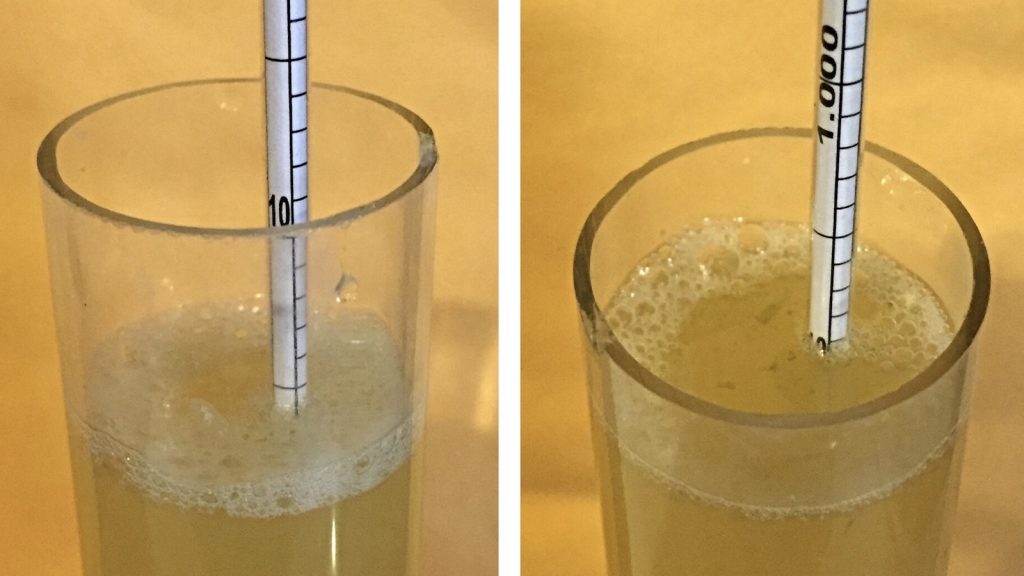
A second measurement 30 hours later revealed no change, so I cold crashed the beers at 32˚F/0˚C for 2 nights before racking to kegs, forgoing my typical gelatin fining process given the style.
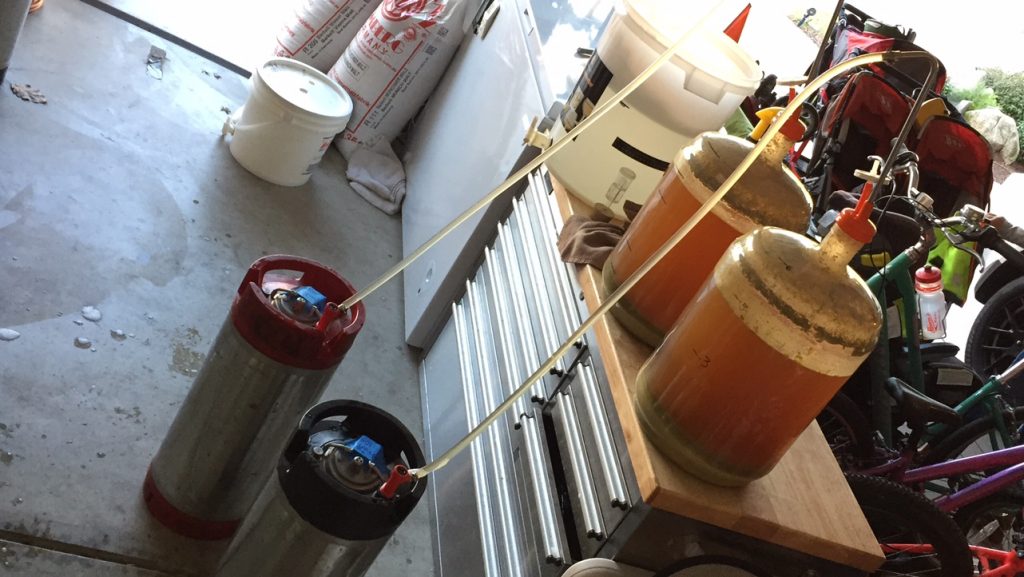
The beers were burst carbonated for a hair over 20 hours before I reduced the CO2 to serving pressure and let them condition for a few more days before serving to participants. At this point, a difference in appearance was fairly noticeable to my eyes, making me all the more curious if tasters would be able to perceive a difference in aroma, flavor, or mouthfeel.
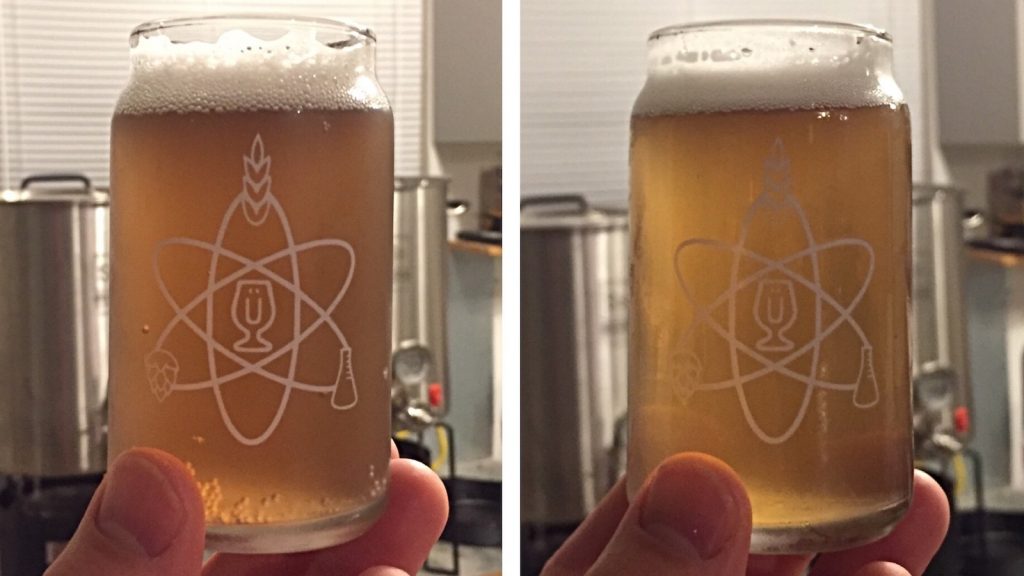
| RESULTS |
A panel of 21 people with varying levels of experience participated in this xBmt. Each taster, blind to the variable being investigated, was served 1 samples of the beer fermented with Wyeast 1318 London Ale III yeast and 2 samples of the beer fermented with Wyeast 1056 American Ale yeast in different colored opaque cups then instructed to select the unique sample. A total of 12 correct selections would have been required to achieve statistical significance, which is precisely the number of tasters of accurately identified the unique sample (p<0.05; p=0.02), suggesting participants in this xBmt were able to reliably distinguish a NEIPA fermented with Wyeast 1318 from one fermented with Wyeast 1056.
The 12 participants who made the correct selection in the triangle test were instructed to compare only the 2 different beers, still blind to the variable in question, and asked about their preference. In all, 8 tasters reported preferring the Wyeast 1318 beer, 3 said they liked the beer fermented with Wyeast 1056 more, and 1 person felt there was no difference between the beers.
My Impressions: From my very first triangle test attempt a couple days after the beers were kegged to my last try once the data was collected, I was capable of distinguishing the odd-beer-out. To me, the beer fermented with Wyeast 1318 was more characterful in a way I can only describe, hesitantly, as juicy. The Wyeast 1056 beer, on the other hand, was notably cleaner with more recognizable hop character, which I experienced as sort of odd given the high chloride to sulfate ratio; it felt like a normal IPA trying to be a New England IPA. To be honest, I wasn’t a huge fan of either of these beers, which isn’t say they were bad, I think I just miss having a classically clear IPA on tap. Still, of the two, the one I drank most often was the batch fermented with Wyeast 1318.
| DISCUSSION |
I approached this xBmt with a hunch based on my belief that the primary character of IPA is hops, and given the liberal dosing in this beer along with the non-significant results from the biotransformation xBmt, figured any yeast character would be well enough hidden to make the beers indistinguishable. Clearly, I was wrong. Not only were tasters able to reliably distinguish the NEIPA fermented with Wyeast 1318 from the one fermented with Wyeast 1056, but I found the task rather easy myself.
Looking at these results in light of past NEIPA xBmts, I’m left even more convinced the style truly is the result of combined forces– high chloride to sulfate water profile, a grain bill consisting of a decent percentage of flaked oats, biotransformation dry hop, and fermentation with specific yeast strains such as Wyeast 1318 London Ale III. I expect this sentiment won’t be shared by everyone, as I’ve seen many NEIPA recipes lately that don’t fit this rubric, and that’s okay, perhaps continued experimentation will allow us to eventually settle on a working definition of this newfangled style.
If you have any experience making NEIPA with different yeasts or you have thoughts about this xBmt, please don’t hesitate to share in the comments section below!
Support Brülosophy In Style!
All designs are available in various colors and sizes on Amazon!
Follow Brülosophy on:
FACEBOOK | TWITTER | INSTAGRAM
If you enjoy this stuff and feel compelled to support Brulosophy.com, please check out the Support Us page for details on how you can very easily do so. Thanks!


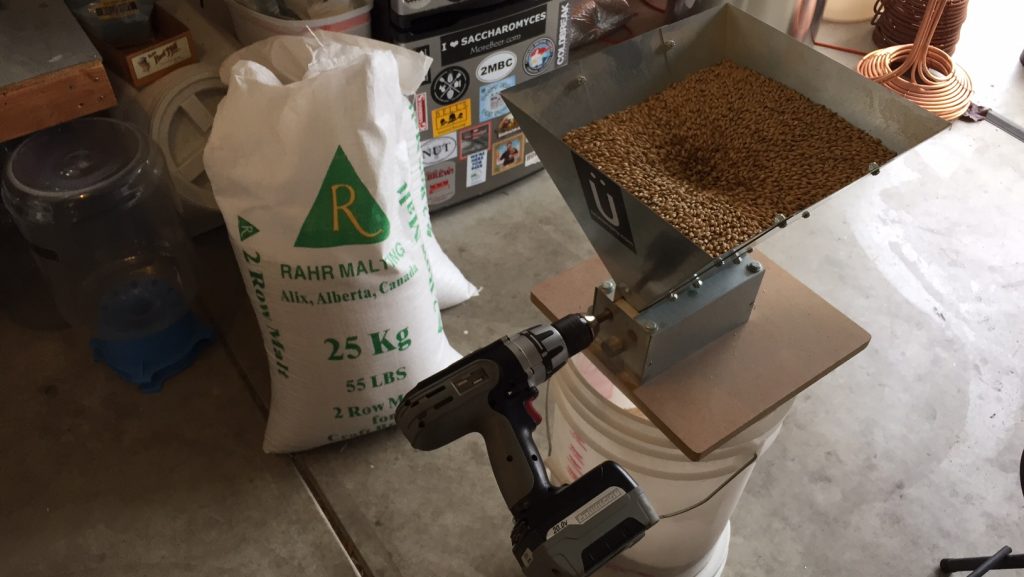
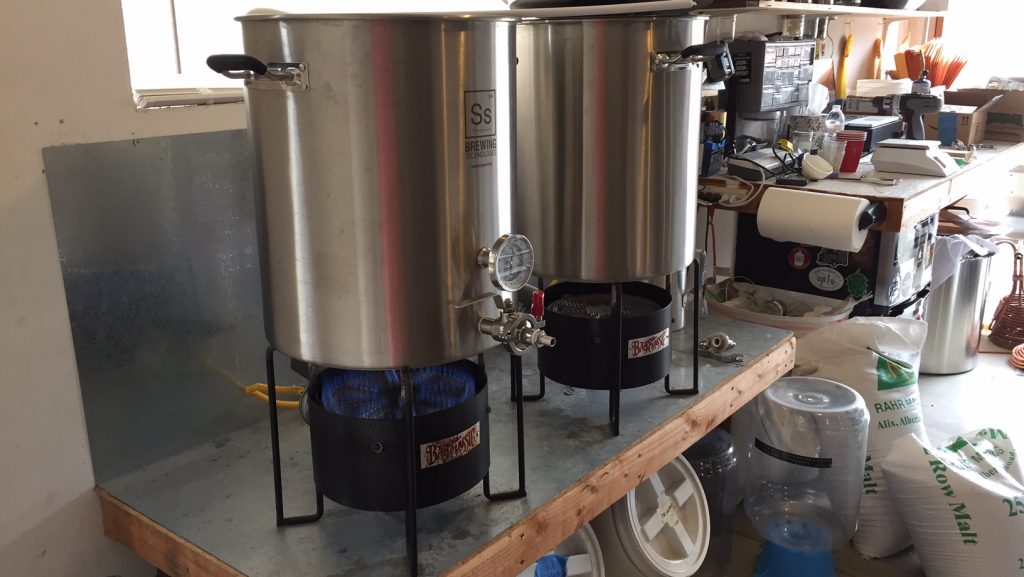
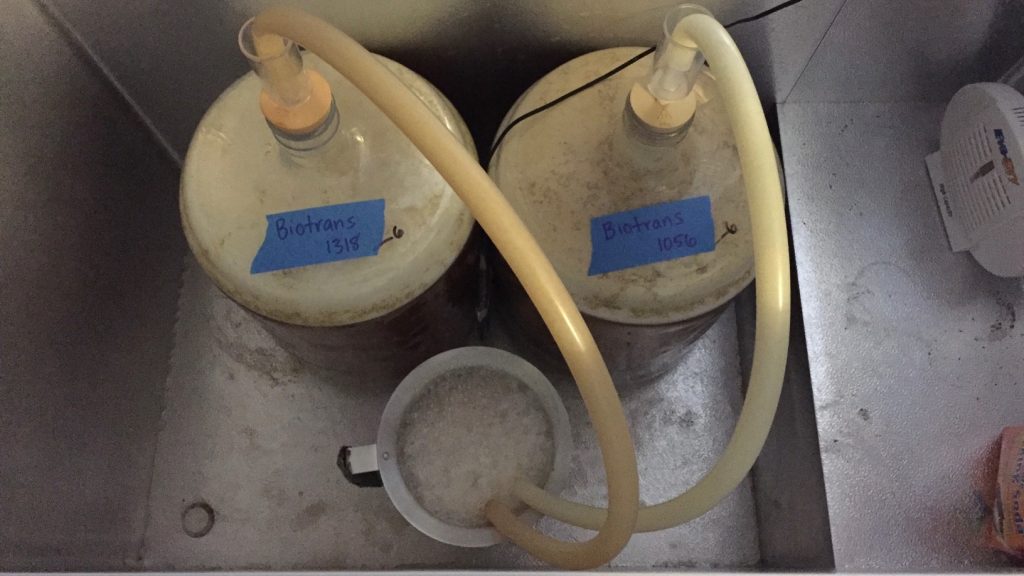










35 thoughts on “exBEERiment | Yeast Comparison: Wyeast 1318 London Ale III vs. Wyeast 1056 American Ale In A Hazy IPA”
i did a sinilar trial and found Chico to be drier and more bitter
It looks like both of the beers did not acheive the proper haze for the style. That 1318 should look like Italian dressing! I think a big factor in this along with the heavy handed dry hopping during active fermentation, is the whirlpool/hop stand. Getting those oils out must to help with the haze. Next, do an experiment with hop stand vs non hopstand with the same yeasts. I’d love to see if my assumptions are correct!
cliff notes version: your assumption is wrong. I’v created total murk bombs that last at least 6 weeks with no hpp stand, and no kettle hops at all, no whirfloc, no gelatin, huge dry hop, wy1318
Just dry hop? That’s awesome! Assuming your dry hop charge was much more than this experiment, I could understand that change.
I always use 2 oz/gallon in my dryhop in one addition during primary. works very well.
“did not acheive the proper haze for the style.”
so, success? The haze was never intended as part of the style, just an aftereffect. Yes, an aftereffect that everyone and their mother uses to identify these beers, but that doesn’t mean they’re all wrong 🙂
they’re all NOT wrong*
I’ve brewed 3 variants so far, with the main variable being yeast with London 3, conan and imperial yeasts citrus. I pushed the temps up on the last batch to mid 70’s to highlight the differences in yeast chatacter, and can differentiate fairly easily, but have a grassy finish because I didn’t drop the temp for the second dry hop addition pre-kegging. I think I’m going to start mixing the 3 strains to see what happens.
I agree, it’s the combination of all the variables that makes an NEIPA. I’m not getting the “juicy” (hate the term) mouthfeel…and I think it’s because I’ve got hard water and haven’t screwed around with water chemistry yet…
I’ve done plenty of “yeast experiments” over the years and Chico seems to win for me, when it comes to hoppy beer. That said, I prefer the classic west coast style to the NE IPA – which is the lamest IPA gimmick in a sea of IPA gimmicks.
I find it odd how 1318 has become known for producing cloudy east coast IPA, as one of my favorite local breweries (Hopworks Urban Brewery in Portland, Oregon) has been using 1318 as their house yeast for almost a decade. I have also used this yeast many times and found it to be reliably flocculant and an excellent yeast for dark beers. I’m not saying it doesn’t work for hoppy beers, but, as with Conan, it probably shines brightest with maltier dark beers.
It’s a shame that so many breweries are cashing in on this popular style and making it a gimmick. The originators of the style weren’t out to make cloudy, murky, or yeasty beer. They were pushing the envelope with hops and how much flavor they could shove into a beer. Unfortunately the masses became obsessed with the “look” which led to homebrewers doing stuff like adding flour to the boil to imitate the appearance only. I am a huge fan of the style and brew them quite often myself. I have always focused on trying to emulate the flavor profile and not the look. The haze comes with the territory and the hopping techniques.
As far as 1318 goes, I’ve used it in traditional English styles and, as you stated, drops clear for me every time. I believe the haze comes from hop oils bonding to the yeast during fermentation and preventing the yeast from floculating completely. For me, at least, the haze diminishes as the keg sits undisturbed in the fridge and the flavor changes with the appearance.
The recipe shows two dry-hop charges, at 4 days and 6 days, but only one is described, at 2-days post-pitch. Can you clarify? Also, my NEIPAs taste great going into the keg (after cold-crashing in carboy) but then always get seriously grassy following carbonation. I’ve heard it hypothesized that burst carbonation might play a role in this. Perhaps a future experiment? As a side note, this experiment describes cold-crashing at day 7 post-pitch. I’m amazed you didn’t get off flavors; I wish I could do fermentations that short! Thanks for the great work.
Like Schulyer Cambell I’ve played around with many yeast strains – and many beer styles, though my all-time favourite is IPA in all its guises. If you like your IPAs to look like orange juice and blow your olfactory and taste senses into the next galaxy then for me, the number one factor that’s crucial to achieving this not oats, chloride/sulphate ratio, or what yeast you use (though these will of course bring their own elements to the party), but how many hops you use, and when. On that subject, this particular XBMT looks a little light on hops – even for a ‘standard’ IPA of that ABV (if there is indeed such a thing as a standard IPA). My best results for a 5 gallon batch have (like Aaron) come from using zero hot side hops, but massive charges of dry hops. The first 200-300g goes in as soon as fermentation starts. Some refer to this as ‘biotransformation’. But I hate crappy terms like that. It’s just an early dry hop, FFS. But whatever you want to call it, this will 100% guarantee you a completely hazed up almost opaque beer that would require months of storing on a high gravity planet before it showed any chances of beginning to clear. The second (300g) charge of hops goes in at around 1.020, and stays there for 3 to 5 days. The only drawback to using 5-600g of dry hops is the ridiculous cost involved, but the result (for me) is more than worth it.
I am more-or-less in agreement with you that the haze appears to be mostly from a massive dry hop. Some of that may be from a lot of yeast in suspension still in some examples as well, but even when the yeast drops out quite a bit, they are still super cloudy. I plan to do my next NEIPA using whirfloc and some kettle hops and maybe gelatin and see how cloudy it is and if i think the flavor is different than that from my current process.
I massively dry hop my normal IPA and it drops crystal clear.
Your approach sounds like an extreme version of a blog post I read recently by Scott Janish (http://scottjanish.com/zero-hot-side-hopped-neipa-hplc-testing-sensory-bitterness/). Although he didn’t seem to have favorable results with surprisingly light aroma and hop flavor.
Marshall, what is the closest you have come in brewing a normal IPA and NE IPA in terms of process and ingredients yet still saw a difference in clarity? If it’s not pretty much the amount/type of dry hops then I am curious what else is left. I know that adjuncts are not required from lots of my own experience. I have a hard time believing the brewing salts impact that much. I guess we’re left with yeast at that point, but I’ve heard on HBT of people using Chico to make super cloudy NE IPA….
The oats beer I made in the flaked oats xBmt was spot on, in my opinion, and it was real good. I’m just partial to the crisper clarity of normal IPA, personally.
I wonder if part of the reason my NE IPA is so murky is that I don’t use whirfloc when I make NE IPA. I just made a WC IPA with whirfloc and WY1056, and it is much clearer than my usual NE IPA even though the hopping is similar and the malt bill is similar. (it did have a 20 min. addn of CTZ and my NE IPA usually has no kettle hops)
Maybe just a personal preference, but Centennial and Columbus seem an odd addition to a NE IPA. Also, I’ve found only doing a FWH addition and no hops during the boil – only for a hopstand and whirlpool is best as it restrains bitterness but gets the juicy hop oils you’re looking for. Actually, my last one had no bittering hops whatsoever and it’s definitely juice in a glass!
I wonder how San Francisco Lager (Cali Common) yeast would compare to London Ale III. Lots of fruity esters there too.
Just curious from what I am reading in the comments about no kettle additions…do you still do a 60 minute boil?
I always do a 60 min boil (90 for Pils malt) when I add ONLY dry hops, but that is just habit. I think you could go less if you want, maybe start with 50, then 40, then 30 and see if it works each time.
After spending time talking to several brewers about the style, I was told a little wheat should be used as well as the oats in a NEIPA to help keep the cloudy going. Also 1318 or the Vermont Gigayeast. I did a similar beer as yours with oats, no wheat, US-05 and Whirlfloc, and kegged perhaps a little early. It was more NEIPA tasting early while still cloudy but more West Coast flavor as it cleared in the keg.
ANYWAY, THANKS FOR THE GREAT WORK!
Ther is a huge difference between a beer that finished at 1.010 and one that finished at 1.015. 1.5x residual sugar … obviously going to taste juicer…what is juice anyway…it’s flavored sugar water. What balances sweetness? Bitterness. If you are in balance at 1.015 and take out 1/3 of the sweetness, the beer will become bitter. This is why giant triple IPAs with 200-300 calculated IBUs usually taste less hoppy than typical 6% IPA with 60-70 IBU. Bio transformation is a cool $20 word but I suggest controll for the FG if you want to claim there is something more going on.
I don’t know if this would work but what if you backsweetened a beer brewed with Chico to the gravity you got with the London Ale yeast? making sure each keg gets same treatment (probably opened, add some water and campden to the London and some boilded extra light dme and some campden to the Chico keg. Purge, mix both well. Keep it very cold. Burst carb and serve fast. Don’t bottle his stuff and don’t let the samples warm up on way to tasting.
https://brulosophy.com/2015/10/12/the-mash-high-vs-low-temperature-exbeeriment-results/
For the same starting wort, it’s true, the wy1318 version should taste rounder/sweeter with the higher FG, assuming the residual sugar difference contains sugars that taste sweet. Still, wy1318 IS much smoother than chico imho. it also is a beast at fermenting. Maybe your pitch was inadequate or maybe it needs more generations. I harvest from starters and get huge attenuation from it.
You got me there. Just finished listening to that podcast. Really enjoying the podcasts! What I took from that is that higher FG did not translate into higher sweetness in that recipe. Not sure the FG difference in the Pilsner repeat was sufficient to make this a generalizable idea but possible. Reasonable to expect similar thing would happen here — although this is higher final gravity due to different yeast choice instead of different final gravity due to mash temp.
The mash temp experiment is amazing. I keep thinking about bud light and the story that it is mashed for hours in the low 140s to get it fully fermentable. I imagine drinking a pint of the higher FG beer would be a different experience than drinking a pint of the low FG beer but can’t offer any way to measure this in the typical sensory panel.
I’ve been experimenting A LOT with high mash temps since reading the original mash temp XBMT. I haven’t noticed any sweetness from high ending mash temps. What I have noticed, I think, is that the beers tend to have worse head retention oftentimes.
I’ve also wondered about doing an ultra-fermented wort vs a super high mash temp wort. I think you could tell the difference there, especially if you use a yeast with low-normal glycerol production (eg Saison yeast produces more glycerol, so you can end with a very low FG and still have a beer that seems average to full bodied.)
I still have it on my list to make a barleywine by mashing at 165F and see if it tastes too sweet!
I’m trying to build a NE IPA recipe. Your dry hop charges on this recipe say 6 days and 4 days, but in the recount of the brewing there is only one mention of a bio-transformation charge being given at two days into fermentation… As a nube (just over 12 months brewing) I need your help with the hop rates. I get a bio-transformation charge, done sometime during high krausen, as a significant part of the NE IPA style. In your recipe was that the 4-day installment, the 6 day installment or both? Was the 6 day installment the more “accepted” dry hop (after krausen has fallen and fermentation slowed)? Thanks!
Hi! I only added 2 dry hops for fun, I wouldn’t normally do that, instead adding a single large dose at high krausen. If you want, you can then dry hop in keg as well, something a lot of NEIPA brewers I know swear by.
I’m building out a NEIPA recipe, too. So… Your recipe has two “dry hop” additions and no mention in the recipe of the “bio-transformation” addition. Question #1)What amount of what types of hops did you use for the “bio-transformation” (high krausen) addition? Question #2) the 4 and 6 day dry hop additions from the recipe, were they still used or dropped? If used, did they follow the recipe as post-fermentation additions? Thanks for helping this NUBE out. Cheers!
How much of taste difference would you attribute to the differing FG? 1.015 is a bit different than 1.009.
Based on my experience, I don’t personally think the FG difference played much of a role at all. Of course, there’s really no way to know for sure.
Do you think oxidation could explain the darker and more juicy and less hoppy character you picked up in the wy1318 beer?
Yeah, I think that’s totally possible.